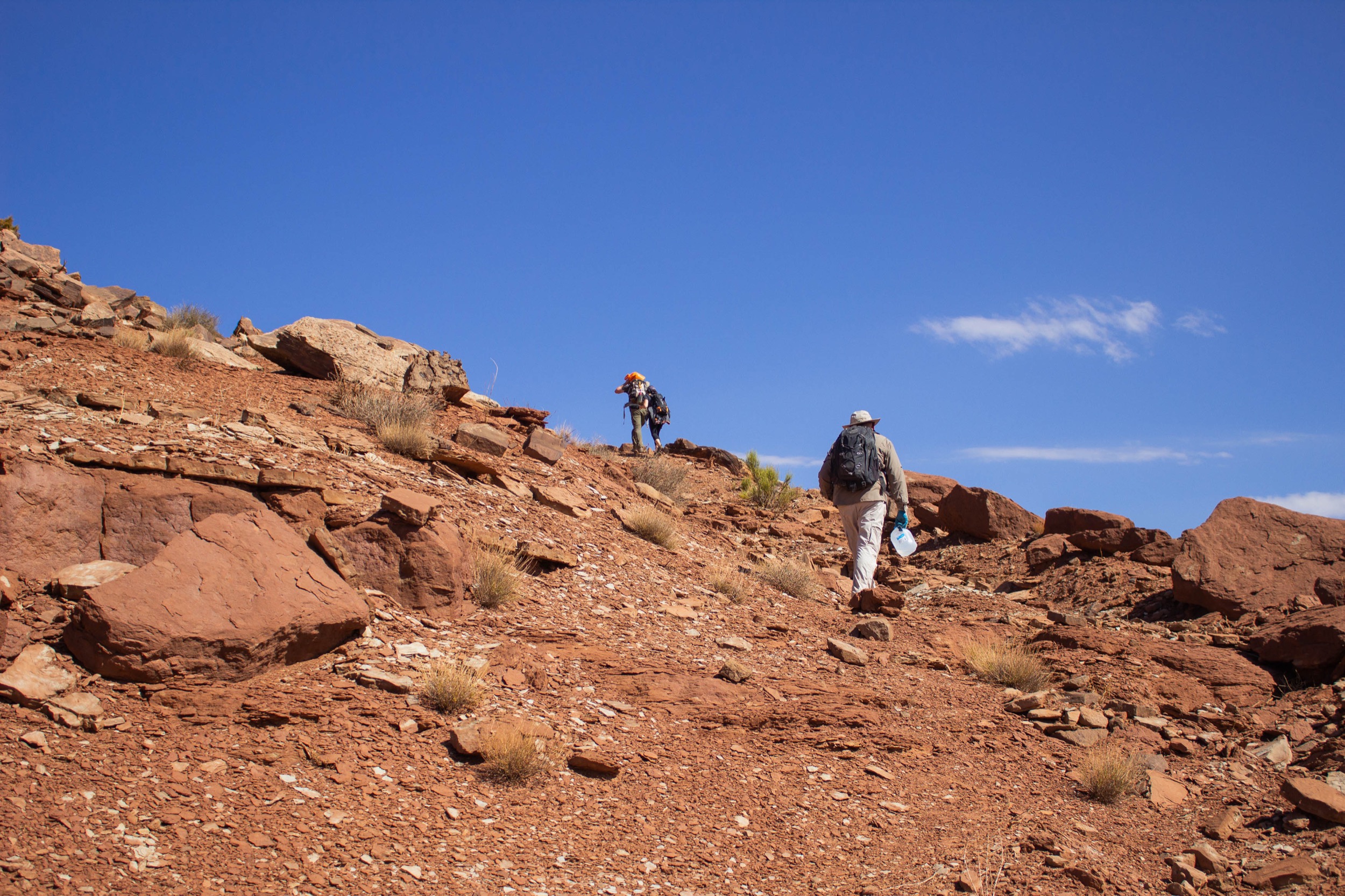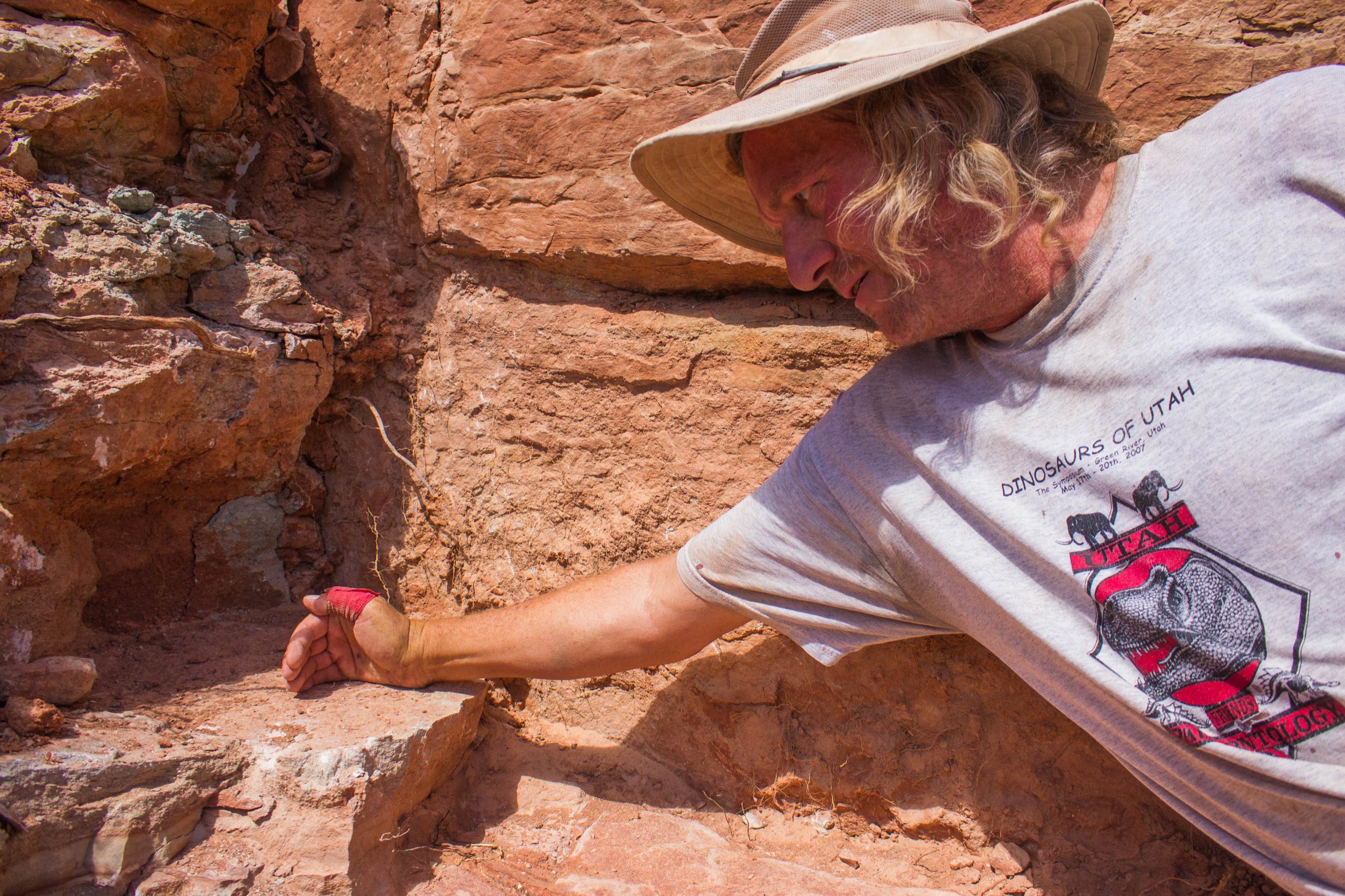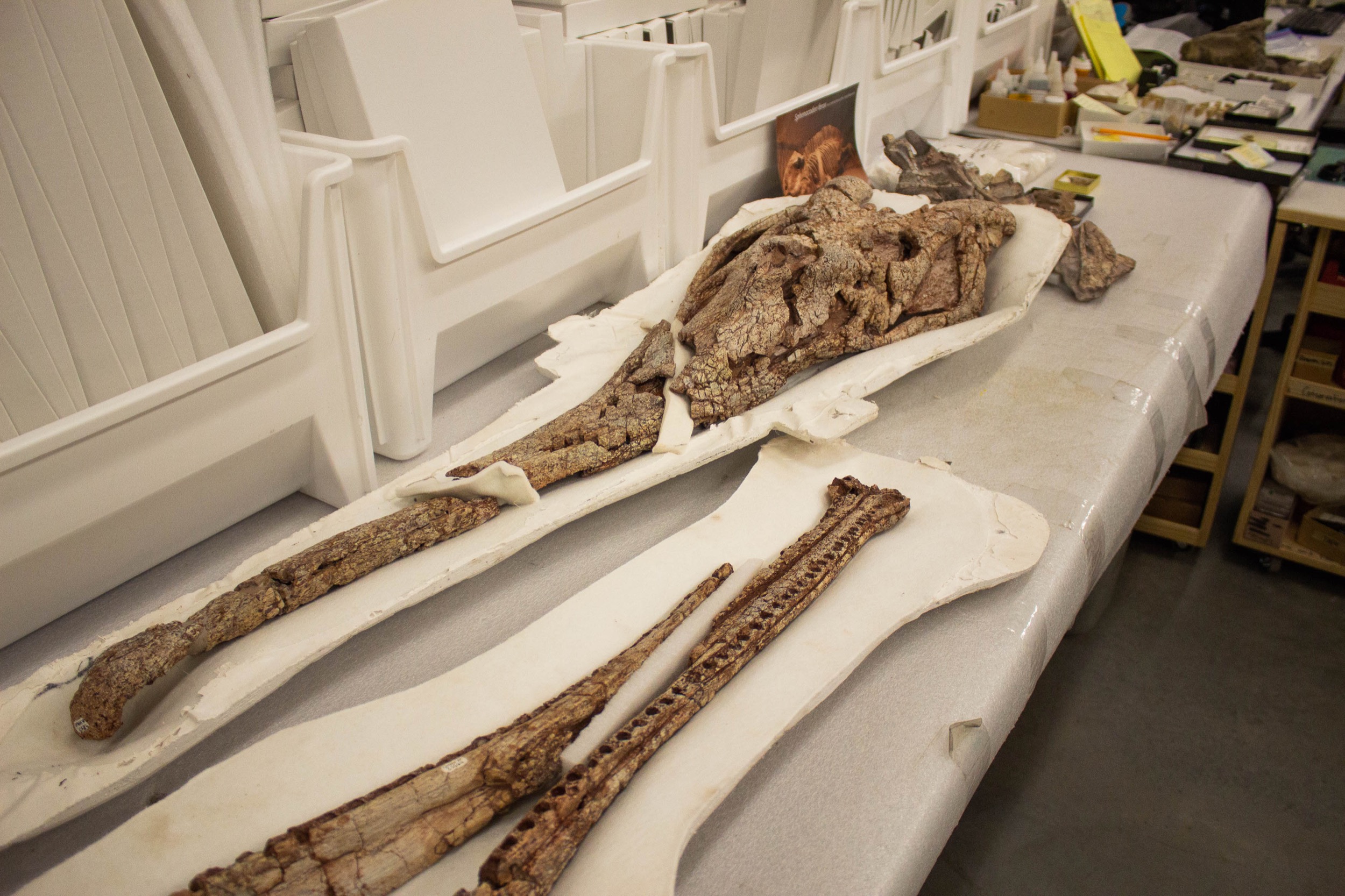Randy Irmis is kneeling next to a prehistoric burial site in the walls of a canyon in the Utah desert.
Just inches under his fingertips is the skull of a 210-million-year-old creature entombed in the gritty sandstone. But as Irmis huddles on the narrow ledge and chips away at the block with a chisel and hammer, he notices—to his alarm—he has unearthed a crack.
“You see the crack there?” Irmis asks Andrew Milner, one of the two other team members on the dig and a paleontologist from the St. George Dinosaur Discovery Site at Johnson Farm.
Milner observes the gash beginning to splice farther down the length of the slab and a nascent network of fissures. “I bet you anything if we pull [one piece of the rock] off, it would split perfectly on the side of the head,” Milner says. Then, reconsidering, he adds with a laugh, “But then again, maybe not.”
“Yeah, I don’t want to chance that,” Irmis agrees.
For fossil hunters Irmis, Milner, and volunteer Cody Rock, it’s been a full day at Bears Ears National Monument—hiking up steep terrain, removing and sawing rock in arid 90-degree Fahrenheit heat, and shimmying precariously along a skinny ledge overlooking Indian Creek. The last thing they want is to damage their prize, especially one so rare to come by: A skull of one of the top predators of the late Triassic, the phytosaur.
Sheer heights, roasting heat, and eye-stinging dust can’t stop a fossil hunter from digging up a paleontological prize. In August, Science Friday journeyed into Indian Creek in Utah with Irmis (second photo), Milner (third photo), and volunteer Cody Rock who spotted the phytosaur skull—the roof of its mouth later revealed in the rock (third photo). Explore more of what it’s like to dig up fossils with paleontologists. Photos by Lauren J. Young
“We’re lucky if we find one skull a season,” says Irmis, curator of paleontology at the Natural History Museum of Utah and associate professor at the University of Utah. “If you think about a skeleton of any animal, there’s only one skull, but there’s many ribs, there’s many vertebrae, there’s two of each type of limb. So you don’t find a lot of skulls. So that’s always really exciting.”
Just by looking at the block still embedded in the ridge, Milner can already imagine the skull, with its signature slim snout. “From what I can see, that’s just a beautiful fossil laying there. I really can. It’s going to be spectacular when it’s prepared.”
When it was alive, this large, crocodile-like reptile lurked in the swamps and rivers of the Triassic—a time period spanning from about 252 to 201 million years ago. These armor-plated beasts could grow up to 30 feet long and used their toothy snouts to snap up prey in land and water. They even feasted on early dinosaurs for dinner.
But then, after thriving for 35 million years, the mighty phytosaurs fell victim to extinction. “It’s always sort of a mystery when you see this group that is super, super successful,” Irmis says. “These are some of the most common fossils we find in the late Triassic, and then they die out pretty suddenly and it’s hard to say exactly why that happened.”
What happened next is a blur in Earth’s history that Irmis and a band of extinction detectives are trying to piece together. It’s a crucial period when the dinosaurs transformed from the underdogs phytosaurs ate for dinner to the thundering, planet-ruling creatures we remember them as today.
It’s known as the End Triassic mass extinction. It’s one of the five most devastating mass extinctions in Earth’s history, a group collectively referred to by researchers as “the Big Five.” While an estimated 80 percent of species were lost, this extinction has “no smoking gun,” says Sterling Nesbitt, a paleontologist at Virginia Tech. “There is nothing we can really put our finger on and say, ‘This is what killed all of these animals,’ compared to what we see in the Permian and in the Cretaceous.”
If you were to trace your finger along the geologic timeline, Nesbitt says, “it’s like you have happy Triassic fauna with a few dinosaurs in there, then big question mark, and then lots of dinosaurs without all the classic Triassic reptiles,” Nesbitt says. This mystery is what drives Irmis, Milner, and a team of paleontologists and volunteers to Indian Creek in Bears Ears National Monument, the hotly contested nature preserve 105 miles south of Moab in southeastern Utah, where they scavenge all the clues they can from a key rock formation.
Investigating this prehistoric crime scene doesn’t just help paleontologists understand past creatures. It’s a case that helps scientists better understand the climate change and species loss we are experiencing today—and might even clue them into our planet’s potentially foreboding future.
Andrew Milner cranks up the rock saw to cut away the block from the cliffside. Video by Lauren J. Young
The desert sand of the Indian Creek Basin feels like a cushion of confectioners sugar.
Every step ends with a gentle puff of fine scarlet dust. The mesas and chimney peaks rise like towering fortresses of red rock, the result of thousands of years of exposure and oxidation of iron. Just below, hugging the base of the sheer cliffs, is the Chinle Formation—a unit of rock found throughout the Colorado Plateau. While Triassic-aged rock is found around the world, the Chinle Formation running through Indian Creek is around 210 million years old, an ideal window into the mass die-off.
Today, wildlife is a rare sight under the intense August sun. “The biggest mammal you are probably likely to see is going to be a cow,” says Irmis, who has been digging with teams of paleontologists in the area since 2009. But 210 million years ago, many of the Triassic creatures roaming this area of Utah could have easily chomped up cattle for lunch.
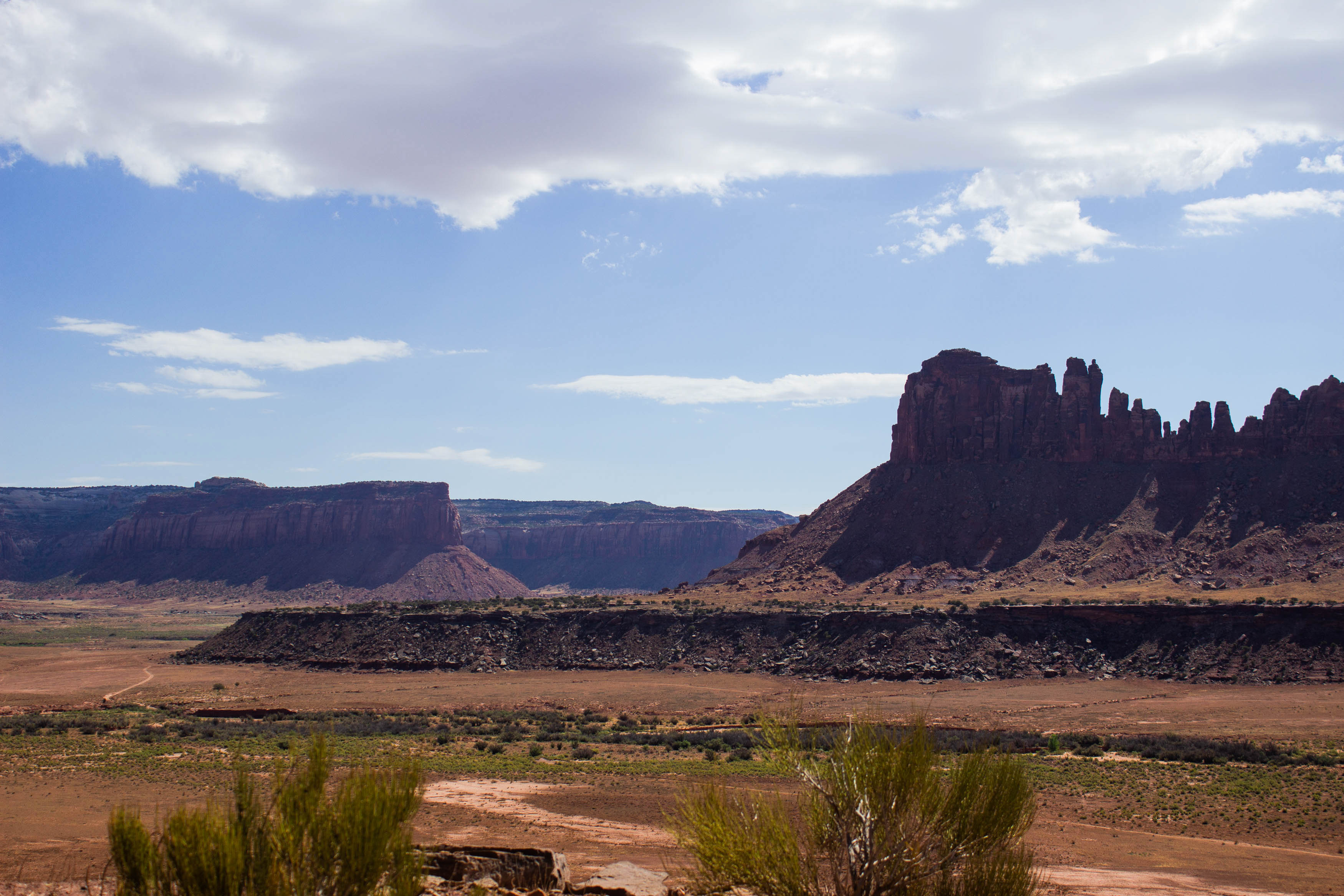
Standing in the middle of Indian Creek’s sweeping canyonlands today, you’ll most likely find yourself one of the largest moving animals in the desert. Photo by Lauren J. Young
Utah—and all of North America and the continents—was a part of the supercontinent Pangea, a landmass hugged by one large ocean called Panthalassa. Triassic Earth as a whole was a much warmer world, what paleontologists and geochemists like Jessica Whiteside at the University of Southampton refer to as a “hothouse world.”
“It was so warm that it lacked ice caps at both of the poles,” Whiteside explains.
Temperatures on land are estimated to have been as high as 140 degrees Fahrenheit at the beginning of the Triassic, with baseline atmospheric CO2 levels at at least 2,000 parts per million—five times the carbon dioxide levels of today. Stretches of deserts in the supercontinent’s interior and unpredictable swings in climate in the tropics and on the coasts would have made the environment near unlivable for human beings. But the dry, warm conditions of what is now Indian Creek were perfect for Triassic critters.
“You wouldn’t have wanted to go swimming in a Triassic river. Too many things to take off a leg or arm.”
During the late Triassic, the Chinle Formation was a broad valley with small rivers, streams, and floodplains. It was likely that herbivores, such as the armadillo-like reptile aetosaurs, munched on the ferns and horsetails growing along riverbanks, while carnivorous rauisuchians gobbled up prey with their steak knife-like teeth. The waterways were probably dominated by toothy phytosaurs and metoposaurs, which had “toilet bowl seat cover”-shaped heads, Irmis says.
“You wouldn’t have wanted to go swimming in a Triassic river,” Irmis says. “Too many things to take off a leg or arm.”
Irmis, age 36, has been enamored with the scaly swamp monsters and the “weird and wonderful place” of the Triassic since 2002, when he was a summer intern at Petrified Forest National Park in Arizona.
“I was into the Triassic before it was cool,” Irmis jokes.
Beyond the phytosaurs and their Triassic brethren, the period was home to some of the earliest dinosaurs. Early species were small, primitive meat-eating bipedal creatures that scurried about the valley.
“We think of dinosaurs as being these dominant lifeforms during their time, but at the beginning of the age of the dinosaurs here in North America, dinosaurs were just small, little side players that probably got eaten,” Irmis says. For example, the slender, four-limbed coelophysis—think Tyrannosaurus rex, but shrunk down to six-and-a-half feet tall—would have weaved through savannah-like fields trying to avoid predators.
“It was a very, very weird world,” says Whiteside, whose video chat handle is named after “vancleavea,” an amphibious, dragon-like Triassic beast. “The debut of every component of our modern ecosystem actually is in the Triassic—so dinosaurs, which exist today as birds, mammals, lizards, amphibians. Most of these have an origin in the Triassic, so it’s a critical interval of time.”
Then, around 201 million years ago, the world cracked apart.
Pangea began to break.
An enormous rift ripped through the supercontinent that stretched from Greenland, along eastern North America, to the western region of Africa. Continental plates shifted and what would eventually become the Atlantic Ocean began to unzip down the supercontinent. Turbulent volcanoes erupted in the region, forming an area known as the Central Atlantic Magmatic Province.
“It’s a massive volcanic province that occupied 6 million square kilometers,” says Whiteside. “To put that into perspective, that represents an area that’s larger than the continental United States and one-third the size of the moon.”
The volcanoes and fissures ejected curtains of lava, leaving behind features like the Palisades in New Jersey and the Amazon flood basalts. Meanwhile, these volcanoes cooked up another planet-altering ingredient—plumes of carbon dioxide, methane, sulfur dioxide, and other greenhouse gases.
The result: Rapid, runaway global warming.
“It’s already a hothouse world, but then there’s massive warming thrown on top of an already hothouse world,” Whiteside says.
Over hundreds of thousands of years, the volcanic rift continued to simmer and spew greenhouse gases. The planet was blanketed with carbon dioxide. Much of Triassic life slowly broiled into extinction.
Plants and food resources were among the first to take a hit. Half of all tropical plant communities went extinct, Whiteside explains. As entire ecosystems shriveled up over the course of generations, species had a harder time finding the food necessary to survive. First the herbivores, then the dominant predators—those fierce phytosaurs and rauisuchians—all became casualties of extinction.
As land plants disappeared, they took their appetite for carbon dioxide with them. The greenhouse gas was likely sucked up by the oceans instead, acidifying the water. Marine environments may have even suffered from ocean anoxia, starving the deep ocean of oxygen and suffocating life there.
These “dead zones” were hostile places to live. Many marine organisms were decimated, from corals to shelled animals to certain types of sponges on the seafloor, explains Kathleen Ritterbush, a paleontologist specializing in mass extinction and marine life at the University of Utah.
Before the End Triassic mass extinction, “the diversity of the kinds of animals we eat on pasta, like the animals that are most abundant as invertebrates in the ocean today—the clams, snails—those are just getting off the ground,” Ritterbush says. “Then this mass extinction just clobbers them in terms of diversity, in terms of abundance.”
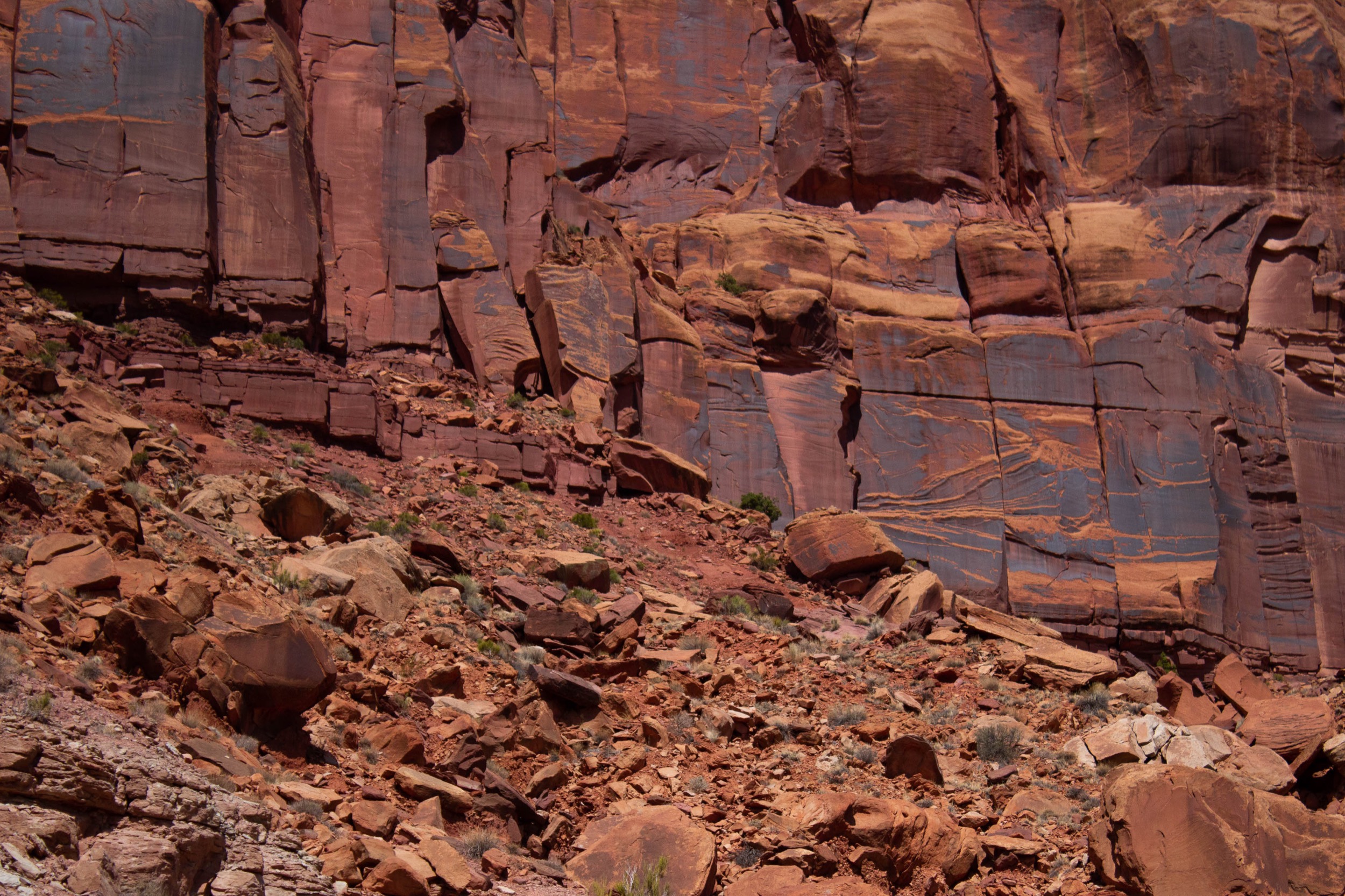
The canyon walls in Indian Creek are striped in red, gold, and tangerine. Photo by Lauren J. Young
Researchers can see hints of this environmental stress riddling the ribbons of crimson and amber rock in the Chinle Formation—tiny, fossilized time capsules that preserve the climate of the past.
Each fossil has its own unique “geochemical fingerprint,” says Celina Suarez, who specializes in “deep-time paleoclimate” at the University of Arkansas. She analyzes Triassic fossils and fossilized soils, following the chemical traces like a carbon breadcrumb trail. The dips and spikes of heavier and lighter carbon—known as carbon isotopes—in a specimen help Suarez pin down the amount of methane, carbon dioxide, and other greenhouse gases in the atmosphere at different points in Earth’s history. The data from oxygen isotopes also help her determine just how hot the environment was when the Triassic was on the brink of extinction.
“At the end of the Triassic, temperatures increase probably two to three times,” says Suarez. “So we probably went from an increase between 3 and 6 degrees Celsius over the course of the Triassic extinction.”
In this warmer, post-apocalyptic, post-phytosaur world, the scene was set for a new dominant species to rise.
Newly empty ecological niches allowed primitive dinosaurs to move their way up. And while the former reigning terrestrial beasts of the Triassic couldn’t handle the change in climate, the dinosaurs had evolved traits that helped them adapt, explains Suarez.
“One of the things that the dinosaurs probably had going for them is that they were, to a certain extent, thermo-regulating,” Suarez says. “There are many flavors of warm-blooded and cold-blooded, but dinosaurs most likely did regulate their temperature. And so that may have been one of the things that allowed them to thrive in these abandoned ecosystems versus aetosaurs and phytosaurs.”
But “what makes a dinosaur? How is a dinosaur unique?” asks Sterling Nesbitt. “We know they are survivors, but is there actually something unique about dinosaurs that allowed them to take over the world?”
There are some potential theories. The fossil record shows that dinosaurs were becoming more abundant and diverse toward the end of the Triassic, Nesbitt says. Additionally, their fossils reveal that they had unique forms of bone development that allowed them to become so large, as they grew from the size of a German shepherd to multiple elephants stacked on top of each other. “We think that maybe dinosaurs had really different ways of growing,” says Nesbitt. “They were highly variable in terms of when they developed certain features in their bones.”
But the conditions and timing around the success of dinosaurs is still a mystery, Nesbitt explains, because of the limited Triassic rock exposed and, respectively, the related lack of Triassic land animal fossils. “It’s not clear if [the dinosaurs] took over before the end of the Triassic or the extinction happened and then they were the survivors and then they took over the world,” Nesbitt says. He calls the End Triassic mass extinction a “black box.”
That’s why Irmis searches for rapid turnover in species, changes in average body size, fewer numbers of total species of phytosaurs and other Triassic lineages in different Chinle layers. As he collects more fossils, he can better fill in the gaps and figure out when ecosystems began to experience climate stress.
Back at Indian Creek, Irmis is standing just around the bend from the phytosaur skull, next to a crumbling canyon wall caked in silty mud.
The sun is beginning to set behind the ridge above him as he removes a loose piece of the fossilized soil—nodules of calcium carbonate from the Triassic. In just a couple centuries, he says, our own soils could record the same carbon levels as the 210-million-year-old grains that disintegrate in his hand.
This red muddy rock is prehistoric soil from the Triassic period. The globular nodules contain calcium carbonate, which can be analyzed for its carbon isotope values. Photo by Lauren J. Young
“We have pretty good confidence that if we don’t do anything about our carbon emissions in a couple of hundred years, we’ll be back to close to late Triassic levels,” Irmis says. “If we want to understand where we potentially could be going, we have to study times like the Triassic period to understand what’s different and what’s the same.”
The conditions during the End Triassic were a recipe for major shifts in ecosystems—rising temperatures, increased rates of carbon emissions in the atmosphere, ocean acidification and anoxia, terms that probably sound familiar today.
Atmospheric CO2 during the Triassic was at least 2,000 parts per million—compared to today’s 409 parts per million, as measured in the October 2018 climate reports. What’s more alarming to Irmis and other scientists are the comparable rates of change. Massive episodic eruptions during the late Triassic rifting doubled the atmospheric carbon dioxide levels in the prehistoric world, according to Irmis and Jessica Whiteside. Today, the burning of fossil fuels has increased carbon dioxide levels in the atmosphere since the Industrial Revolution by more than 40 percent, a much shorter amount of time.
Similar rising patterns are seen in projected temperature. While the temperatures may not be as high as the End Triassic mass extinction, the change is occurring over a very short amount of time: “We’ve never seen anything like this really before in our history,” says Suarez.
“We have pretty good confidence that if we don’t do anything about our carbon emissions in a couple of hundred years, we’ll be back to close to late Triassic levels.”
A global increase of 2 degrees Celsius may not sound like a lot, Suarez says, but “the magnitude of temperature increases in [places] like the Arctic and the Antarctic is much greater. It’s more like 6 degrees Celsius to 10 degrees Celsius. So those environments where animals live are in big trouble.”
Some experts are already predicting that we are currently staring down the barrel of another mass extinction—a sixth mass extinction, a new family member to the Big Five.
No species lives on forever. Extinction is ingrained in the natural ebb and flow of our planet, species flourishing and fading throughout time. But perhaps the most unnerving aspect of the sixth mass extinction is that it is not natural—it would be driven by humanity’s own devices. One study suggested that more than 80 percent of species on Earth and more than 90 percent of species in the ocean have yet to be discovered, and already many of them will be lost before they are found. Right now, Suarez says, we are experiencing a level of diversity crisis.
“Our timeframe for defining mass extinction is on the order of thousands of years, so we have to be careful,” she says. “However, the geology part of me that understands the long-term carbon cycle sees this as a major, major event. And so, if you check back with me in a hundred thousand years or a million years, I’d say probably we’ll see this as a mass extinction.”
Researchers and climate scientists use forecast models and projections to try to better understand what might happen to the Earth’s climate in the future if our carbon production persists at today’s rate. But concrete climate data already exists; the evidence is just embedded in prehistoric rock.
"All these animals lived in the past and they have all experienced climate change,” Suarez says. "We are always concerned with what’s going to happen in the future with modern rapid climate change. Well, that experiment has already been run in the past. We just have to go back into the past and look at it and evaluate it.”
While none of the Big Five, the End Triassic mass extinction included, is a perfect predictor of our future climate, they’re still useful analogs. Paleontologists and geochemists look to the fossilized remains of past mighty creatures as snapshots of how climatic changes and life on Earth interact. Maybe these “natural experiments” as Suarez describes, can help us avoid, or even postpone, an unnatural sixth mass extinction.
“We still have a bit of a chance to stop it from happening, at least at the level of these other five mass extinction events in the geologic record,” says Irmis.
What’s less clear is whether humans will be around to witness a sixth mass extinction—if it occurs.
“Probably, we won’t be around in a million years,” Suarez says. “Most species last not much more than about a million years. Maybe our ancestors will be around, whatever species we evolve into.”
As Irmis and his two fellow fossil hunters wrap up their digging back in Indian Creek, they leave the phytosaur skull nestled in the canyon wall. It’ll have to be transported down the craggy slope back to camp another day. It’s still the beginning of the long process. Only after careful preparation in the lab at the Natural History Museum of Utah can Irmis get his hands on the bones to determine the species and potential size of the animal, along with other data he needs to fill in pieces of the Triassic puzzle. And, as a paleontologist, he’s used to working on a longer timeline, one that unfolds over hundreds of millions of years.
For Irmis, the death of the phytosaur is just the beginning of the story.
Driving back to camp through the canyons. Video by Lauren J. Young
Our methods
Why Is This A Story Worth Telling?
Often we look to models and projections to understand the future of our planet, but so much can be learned from the past. The End Triassic mass extinction, during which the dinosaurs came out on top, holds many similarities to today’s climate change yet very little is known about it. The fossils of the Triassic provide crucial information for filling in Earth’s early timeline, and the paleontologists studying this period’s climate could help us understand our changing climate today.
How Did We Report This Piece?
We traveled to Indian Creek in Bears Ears National Monument to join paleontologists for two days of a fossil dig in August 2018. We also visited the paleontology collections and Fossil Preparation Lab at the Natural History Museum of Utah in Salt Lake City.
Many experts and scientists provided us background information and research for this piece. To report the story, we spoke to at least 14 paleontologists, geochemists, and climate researchers, as well as a handful of volunteers out in the field.
Further Reading
Discover why Utah is a gold mine for fossils and the process of getting the phytosaur out of the rock with Randall Irmis and his team on Science Friday.
Listen to a discussion on Science Friday about the future of paleontology in Utah with the recent reductions of two of Utah’s national monuments, including Bears Ears National Monument.
Listen to science journalist and author Annalee Newitz talk about mass extinctions and how we might be able to survive a sixth one in a Science Friday interview.
Learn more about what experts are saying about the sixth mass extinction in a conversation with Elizabeth Kolbert, author of The Sixth Extinction: An Unnatural History.
Discover more about “the Big Five” from Nature.
Credits
Written by Lauren J. Young
Audio by Katie Feather
Reported by Katie Feather and Lauren J. Young
Site design by Daniel Peterschmidt
Edited by Christopher Intagliata and Brandon Echter
Fact checking and copy editing by Michele Berger
Art by Franz Anthony
Special thanks to Christian Skotte, Johanna Mayer, Luke Groskin, Jen Fenwick, Danielle Dana, and the rest of the Science Friday staff.
This story was reported from public lands with the permission of the Bureau of Land Management in Utah.
Thank you to Northwestern University Knight Lab, whose free tools SoundCite and Timeline were used in the making of this project.
Published December 7, 2018

